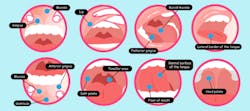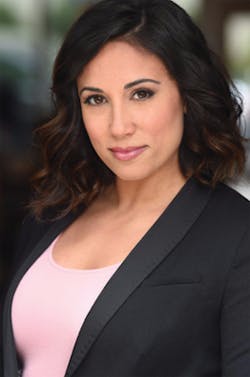Oral cancer: Creating a more connected conversation
The words “oral” and “cancer” typically cause some sort of uncomfortable reaction among patients during the dental appointment. As we progress in our field with advanced prevention techniques and technology, it’s important to genuinely connect with our patients during this time and invite them into a conversation about their health, including their risks, instead of disconnecting and falling into a routine. Approximately 53,000 people will be newly diagnosed with oral cancer in 2019, (1) so it is imperative that this exam is done well and done with care. April is Oral Cancer Awareness month, and knowing the updated facts on the disease provides a great opportunity to engage your patients.
Fast facts
- When found at early stages of development, oral cancers have an 80 to 90% survival rate. (1)
- Men are twice as likely to get oral cancer. (1)
- Oral cancer is most prevalent in the following populations: white (17.4%), black, (14.4%) and native american Men (13.2%) (statistics are out of every 100,000) (1)
- Thirty percent of oral cancer is in the tongue, 17% is in the lip, and 14% is in the floor of the mouth. (2)
- Tobacco and alcohol–related lesions are found primarily on the anterior of the tongue. (3)
- HPV-related oral cancer is on the rise in men and women in their twenties and thirties. (2)
- HPV-related lesions favor the back of the throat. (3)
- About 70% of all oropharynx cancer is caused by HPV. (2)
Scripts
I first start by introducing what kinds of tools I am going to use to do the exam. In my office, we use a handheld scope that uses natural tissue fluorescence to detect abnormalities not visible to the naked eye,or the “laser light beam” detector as I like to call it with my patients. (4) I usually follow with, “Now we move on to the ‘disco party’ portion of the appointment with the laser light beam show.” Kinda corny? Yes, but very effective. The patient is instantly engaged. I then explain what this tool is, what I am looking for during this screening, and why it is important.
The tobacco/alcohol discussion
I ask patients if they have ever used, or currently use, alcohol or tobacco. To help ease any hesitancy, I also say something like, “I am being a little nosey, but just want to know how often I should do this exam for you.” If they say, “Yes, but it was a long time ago,” I try to get specifics. Everyone’s perception of “a long time” or “a lot” is different. Asking about the amount, frequency, and duration is going to give you the answers you need to make a professional recommendation. Try to keep this part of the appointment as shame free as possible and come from a more relatable and kinder place. If your patient is high risk, he or she should be informed screenings will be needed more often (3), and you are happy to provide resources of tobacco and alcohol cessation when he or she is ready to help lower his or her risk.
The HPV discussion
I also let patients know that smoking isn’t the only risk factor. The HPV types 16 and 18 have also been linked to cancer, so we must screen everyone at least once a year since this type of cancer has a higher treatment success rate when found in its early stages. (1) Bringing up sexual history can be extremely uncomfortable at the dental office for both the patient and the provider. However, always approaching it with a professional, friendly, and shame-free attitude will make patients feel a lot more comfortable. A good way to navigate this is to include yearly screenings for everyone who comes into the office (not just certain individuals) and simply inform patients of the facts. My office does a great job of informing patients why it is important to do an oral cancer screening on every patient because of the rising oral cancer rates with HPV. If everyone is used to doing this exam yearly, your patients will start to expect it, making it easier to have these specific conversations and creating an environment your patient can feel comfortable in and trust.
Where to look:
External screening
- Face
- Eyes
- Ears and nose
- Lips
- Thyroid
Internal screening
- Buccal Mucosa
- Tongue
- Floor of the mouth
- Hard and Soft Palate
- Tonsils
Assessment of high-risk patients:
- Tobacco use
- Alcohol use
- Combination of alcohol and tobacco consumption presents highest risk
- HPV types 16 and 18
- Chronic trauma (e.g., biting of tongue and cheek)
Common oral cancer sites
Assessment for visual signs
Signs of oral cancer and differentiating factors
- O: Irregular “O” shape
- R: Redness, white or rare color, irregular dark fluorescence under scope
- A: Areas: floor of the mouth, back of the throat, side of the tongue, underside of the tongue, lower lip and buccal mucosa
- L: Lesions on and around the tongue and buccal mucosa sometimes can be mistaken for canker sores
Although the oral cancer screening portion of the appointment can be a bit awkward, it doesn’t have to be! Ultimately, doing right by your patients by asking engaging yet specific questions is vital to a thorough check-up and can help save lives. Creating a genuine connection around the discussion of oral cancer will allow your patients to literally “open up.”
References
1. The role of dental and medical professionals. The oral cancer foundation website. https://oralcancerfoundation.org/dental/role-dental-medical-professionals/. Accessed April 10, 2019.
2. National Cancer Institute. Oral Cavity and Pharynx Cancer: Did You Know? Video Series. YouTube. https://youtu.be/98ZD4V4RYcY. Published April 24, 2017. Accessed April 10, 2019.
3. Head and Neck Cancers. National Cancer Institute website. https://www.cancer.gov/types/head-and-neck/head-neck-fact-sheet. Updated March 29, 2017. Accessed April 10, 2019.
4. VELscope oral screening. LEDApteryx website. https://ledapteryx.com/velscope/. Accessed April 10, 2019.


